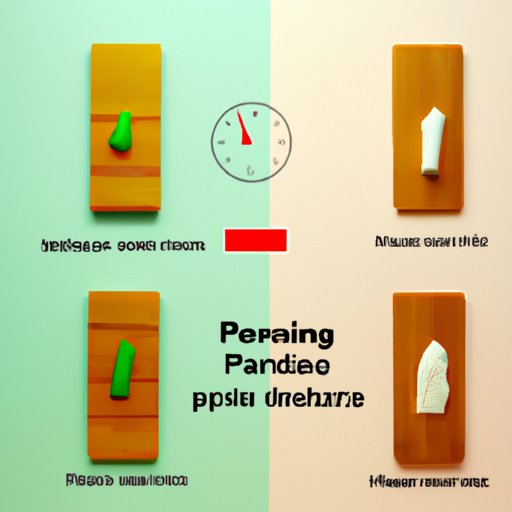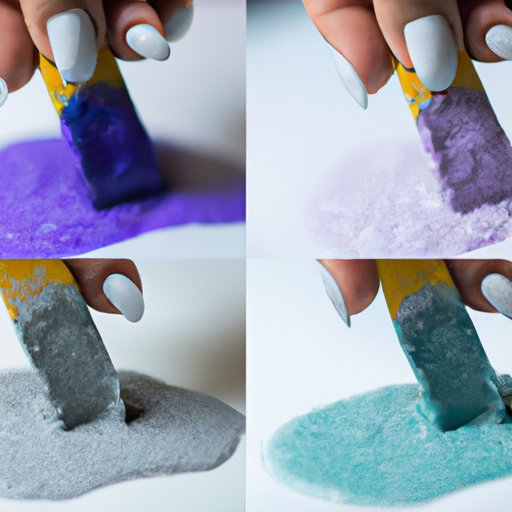I. Introduction
Painting can be a fun and rewarding DIY project, but waiting for paint to dry can be a frustrating experience. Whether you are painting your walls, furniture, or artwork, nobody wants to wait around for the paint to dry before moving on to the next step in their project. This article will provide solutions to this problem by exploring how long it takes for paint to dry and offering tips and tricks to help speed up the process.

II. The basics of paint drying time
How long paint takes to dry depends on a variety of factors, including humidity, temperature, and surface type. In general, it takes paint 24-48 hours to dry completely, but some factors can speed up or slow down the process.
For instance, if it’s humid outside, paint can take longer to dry than it would in a dry environment. Similarly, if it’s hot outside, the paint will dry faster. The surface you’re painting on also makes a difference: porous surfaces like wood or drywall absorb paint more quickly than non-porous surfaces like metal or plastic.
It’s important to wait the recommended time before applying another coat or using the painted surface. If you don’t, the paint could smudge or smear and you’ll end up redoing the job.
III. Tips for speeding up paint drying time
If you’re in a hurry to get your painting project done, there are a few things you can do to speed up paint drying time. One option is to use a fan to circulate air around the painted surface. This will help remove excess moisture from the air, which will speed up the drying process.
Another option is to open windows or doors to increase ventilation. This will help dry the paint faster because it allows more air to circulate around the painted surface. If you’re painting in a humid environment, you can also use a dehumidifier to remove excess moisture from the air.
IV. Different types of paint and their dry times
There are several different types of paint, and each has a different drying time. Oil-based paint, for example, can take up to 7 days to dry completely. Acrylic paint, on the other hand, dries much faster, typically within a few hours. Watercolor paint dries even faster, often within minutes.
When choosing paint, it’s important to consider the drying time, as well as other factors like color, finish, and durability. Each type of paint has its own strengths and weaknesses, so it’s important to choose the type that is best suited for your specific project.
V. Factors that influence paint drying time
Humidity and temperature are two of the biggest factors that influence paint drying time, but they’re not the only ones. Other factors include surface texture, air circulation, and the thickness of the paint layer.
For example, a thicker layer of paint will take longer to dry than a thinner layer because there is more moisture that needs to evaporate. Similarly, if you’re painting in a room without proper ventilation, the paint will take longer to dry because there’s less airflow.
VI. What happens if you paint over paint that hasn’t fully dried
If you paint over paint that hasn’t fully dried, you can end up with wrinkling or peeling. The new coat of paint will trap the moisture from the still-wet layer below, which can cause the top layer to buckle or bubble.
To prevent this from happening, it’s important to wait until the first layer of paint is completely dry before applying another coat. This will ensure that there is no excess moisture trapped under the new layer of paint.
VII. How long to wait before recoating painted surfaces
The amount of time you should wait before recoating a painted surface depends on a few factors, such as the type of paint, the thickness of the layer, and the temperature and humidity in the room. As a general rule, it’s best to wait at least 24-48 hours before applying another coat of paint.
One simple way to tell if a surface is dry enough for another coat of paint is to use the “thumb test.” Press your thumb against the painted surface and apply pressure. If the surface feels tacky, it’s not dry enough for another coat. If it feels dry and doesn’t leave a thumbprint, it’s okay to move on to the next coat.
VIII. Common mistakes made when painting and waiting for it to dry
There are a few common mistakes people make when painting and waiting for it to dry. One of the biggest mistakes is applying too thick of a layer of paint. Not only will this take longer to dry, but it can also lead to wrinkling or cracking.
Another common mistake is painting in a room without proper ventilation. This will prolong the drying process because there’s no air circulation to help remove excess moisture from the air.
Using the wrong type of paint for the surface you’re painting on can also lead to longer drying times. For example, using oil-based paint on a non-porous surface like metal can cause the paint to take longer to dry because it’s not able to soak into the surface like it would a porous material like wood.
IX. Conclusion
Painting can be a fun and rewarding project, but waiting for paint to dry can be frustrating. By understanding the factors that influence paint drying time and taking steps to speed up the process, you can make your painting projects faster and more efficient.
Remember to choose the right type of paint for your project, wait until each layer is completely dry before applying another coat, and make sure you’re painting in a well-ventilated area. By following these tips and tricks, you’ll be able to tackle your painting projects with confidence and ease.
